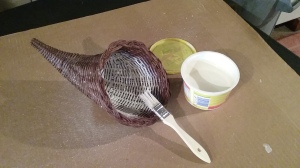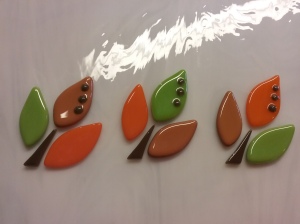A garden gate was nowhere in my radar this fall. But, after pulling some beautiful rusty sunflowers from a pile of junk someone dropped off at our house, I had to use them. Having a husband in the salvage business does have its rewards. Anyway, they were on tall stems and looked like they had held a candle or solar light of some sort.

I laid them on a rusty gate, along with a faded, metal flower. The materials looked good together, but the sunflowers were too small to use. The yellow flower would be the perfect size, but I only had one. What to do?

I left everything laying out, pondering over them as I piddled around with other things. I really wanted to use those rusty flowers, I just wished they were bigger. Could I do something to them to make them look bigger? Put something behind them, and make them the centers? That was it! Once I began looking at them as the centers of flowers, things started coming together.
The plan – cut two new flowers from scrap aluminum, using the yellow flower and its leaves as a pattern, then give each a rusty flower center to pull them together.
First, the sunflowers had to be taken apart. With my husband’s help, the welded hinges and other small pieces were removed carefully with a low temp torch. I slowly pulled them off with pliers as he controlled the heat. The stems were saved for later.
Flower pieces and leaves were cut from thin aluminum.

I taped the flower head pieces together and wired them to the gate to determine their placing. The leftover stem pieces were held up to the flowers and cut to the lengths needed, making sure they were long enough to go behind and be glued to the back of the flower. The placing of the leaves was determined the same way. Shorter leftover stem pieces were curved slightly and cut for the leaf stems.

File the sharp edges of the aluminum pieces. Buff them with steel wool before priming and painting.


Glue the rusty sunflower centers to the front of the flowers. NOTE – Always when gluing, the paint must be scraped from the surfaces to be glued – both surfaces must be clean and paint free. Let dry.
The short curved stems were glued to the backs of the leaves. Let dry.
The flower was placed face down and propped level to glue the stem to the back of the flower. Let dry. Touch up paint, over the glue.
Glue leaves to the stem. Let dry. After the leaves were dry, the flower was turned over and glued on the front of the leaf stems too. Let dry. The stems and leaves were painted.

The gate was scrubbed clean and sprayed with clear sealer.
The flowers were wired to the gate in several places along the main stem and behind the flower. Because they were glued on, I avoided putting any pressure on the leaf stems. I painted a little green paint over wires that were showing. A small amount of white paint was lightly sponged on the rusty centers. The thin aluminum petals and leaves were curved and shaped to add dimension.
The little dragon fly from the yellow flower was wired on after it was brightened up with some glass wings and a nugget. I don’t know what I’d do without my squeeze clamps. 🙂


And there you have it! Now, let’s just hope winter doesn’t get here before Thanksgiving.



I’m stepping clear out of my comfort zone with my next post and will be attempting an easy Christmas sewing project. We’ll have to see how that goes …
Please, mask up, wash those hands, and stay healthy and safe my friends, I’ll be back soon.














































